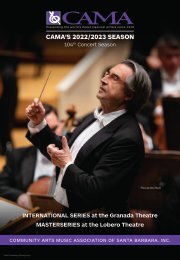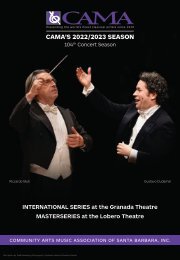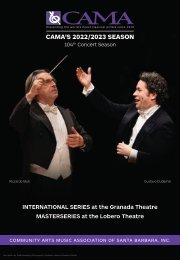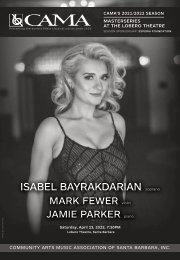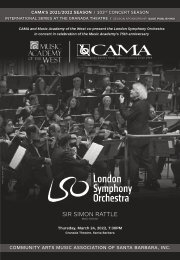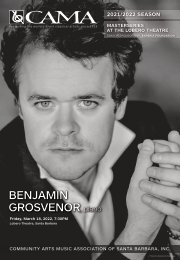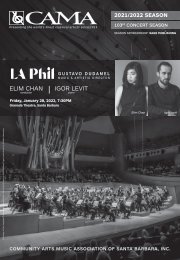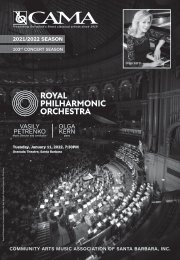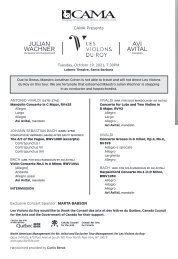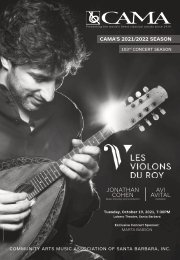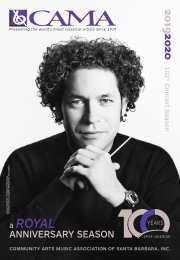Program Book / October 10, 2022 / CAMA Presents the City of Birmingham Symphony Orchestra with Mirga Gražinytė‑Tyla and Sheku Kanneh‑Mason
The Board of Directors of Community Arts Music Association dedicate this concert to the memory of Her Majesty The Queen Elizabeth II and of Her Majesty's 70 years of service to the people of the United Kingdom, the Realms, and the Commonwealth. MONDAY, OCTOBER 10, 2022, 7:30PM City of Birmingham Symphony Orchestra Mirga Gražinytė‑Tyla, Music Director Sheku Kanneh‑Mason, cello The City of Birmingham Symphony Orchestra is the flagship of musical life in Birmingham—and one of the world’s great orchestras. The tradition began with their very first concert back in 1920—conducted by Sir Edward Elgar. The CBSO became internationally famous when conductor Simon Rattle took the helm in 1980. In 2016, the CBSO welcomed the appointment of Mirga Gražinytė-Tyla, a native of Vilnius, Lithuania, as its Music Director, following her time with the Los Angeles Philharmonic as a Dudamel Fellow, Assistant Conductor, and Associate Conductor. British cellist Sheku Kanneh-Mason became a household name in 2018 after performing at the wedding of Prince Harry and Meghan Markle at Windsor Castle, watched by nearly two billion people globally. Sheku’s album Elgar on the Decca Classical label made him the first cellist in history to reach the UK Top 10. PROGRAM: RALPH VAUGHAN WILLIAMS: Fantasia on a Theme by Thomas Tallis SIR EDWARD ELGAR: Cello Concerto in E Minor, Op.85 MIECZYSŁAW WEINBERG: “Jewish Rhapsody,” from Festive Scenes, Op.36 CLAUDE DEBUSSY: La Mer PRE-CONCERT LECTURE: Jennifer Kloetzel, Professor, Cello and Head of Strings, UCSB Department of Music Sullivan Goss Art Gallery, 11 E. Anapamu Street, Santa Barbara Doors open 5:45PM ⫽ Lecture 6:00–6:40PM Presented by the CAMA Women’s Board •
The Board of Directors of Community Arts Music Association dedicate this concert to the memory of
Her Majesty The Queen Elizabeth II and of Her Majesty's 70 years of service to the people of the
United Kingdom, the Realms, and the Commonwealth.
MONDAY, OCTOBER 10, 2022, 7:30PM
City of Birmingham Symphony Orchestra
Mirga Gražinytė‑Tyla, Music Director
Sheku Kanneh‑Mason, cello
The City of Birmingham Symphony Orchestra is the flagship of musical life in Birmingham—and one of the world’s great orchestras. The tradition began with their very first concert back in 1920—conducted by Sir Edward Elgar. The CBSO became internationally famous when conductor Simon Rattle took the helm in 1980. In 2016, the CBSO welcomed the appointment of Mirga Gražinytė-Tyla, a native of Vilnius, Lithuania, as its Music Director, following her time with the Los Angeles Philharmonic as a Dudamel Fellow, Assistant Conductor, and Associate Conductor. British cellist Sheku Kanneh-Mason became a household name in 2018 after performing at the wedding of Prince Harry and Meghan Markle at Windsor Castle, watched by nearly two billion people globally. Sheku’s album Elgar on the Decca Classical label made him the first cellist in history to reach the UK Top 10.
PROGRAM:
RALPH VAUGHAN WILLIAMS: Fantasia on a Theme by Thomas Tallis
SIR EDWARD ELGAR: Cello Concerto in E Minor, Op.85
MIECZYSŁAW WEINBERG: “Jewish Rhapsody,” from Festive Scenes, Op.36
CLAUDE DEBUSSY: La Mer
PRE-CONCERT LECTURE:
Jennifer Kloetzel, Professor, Cello and Head of Strings, UCSB Department of Music
Sullivan Goss Art Gallery, 11 E. Anapamu Street, Santa Barbara
Doors open 5:45PM ⫽ Lecture 6:00–6:40PM
Presented by the CAMA Women’s Board
•
You also want an ePaper? Increase the reach of your titles
YUMPU automatically turns print PDFs into web optimized ePapers that Google loves.
suggestion that he was painting specific
scenes in music. He had no interest in pictorialism
or program music. A few months
earlier, in a review for a Paris newspaper,
he had written that the popularity of
Beethoven’s Pastorale Symphony “rests on
the common and mutual misunderstanding
that exists between man and nature.” He
wrote that the birdcalls in that symphony
were more like the art of the 18th-century
creator of a famous mechanical duck “than
drawn from nature’s book. All such imitations
are in the end useless—purely arbitrary
interpretations.” Elsewhere he wrote
that the Pastorale succeeded “simply because
there is no attempt at direct imitation,
but rather at capturing the invisible
sentiments of nature.” If Debussy thought
that Beethoven could not pull off an imitation
of nature in music, he certainly was
not about to try it himself. Yet he acknowledged
that a musical work about the ocean
“could turn out to be like a studio landscape,”
but concluded, “I have countless
reminiscences. This matters more, in my
opinion, than a reality.”
The determination to depict the ocean
generally rather than specifically led to
changes in titles. In a 1903 letter to his publisher,
Debussy proposed “The Sea; Three
symphonic sketches for orchestra: I. Beautiful
sea by the bloodthirsty islands. II. Play
of the waves. III. The wind makes the sea
dance.” By the time Debussy finished La Mer
in March 1905, he had changed the title of
the first movement to “From dawn to midday
on the sea,” and that of the last movement
to “Dialogue of the wind and the sea.”
The original title of the first movement was
the title of a short story by Camille Mauclair.
Though Debussy liked the contrast
between beauty and blood-thirst, he gave it
up, probably because using Mauclair’s title
might give the idea that the music tracked
the story.
The three movements have a similar
feel, perhaps because some similar building
blocks went into them. The first thing
heard above the quietly droning basses is a
rising progression built on the whole tones,
fourths and fifths, and using rhythmic figure
of a short note on the downbeat moving
to a much longer one. Fourths and fifths
stacked on each other have a strong, forthright
quality (they are the key elements of
fanfares) but also a sort of blankness (the
open strings of violins, violas and cellos are
tuned in fifths, those of double basses and
guitars are in fourths). The fourth and fifths
recur throughout the work without calling
much attention to themselves, since they
are such a fundamental part of tonal music,
but they bring an elemental quality to
the music, as if conveying something wide
and open and vast, such as, for example,
the ocean. The short-long rhythmic figure
is easier to pick out, and conveys a sense
of poignancy in places and sheer power in
others, as when the brass thunder it out at
the end of the first movement.
©️ 2022, Howard Posner
20 CAMA'S 104 TH CONCERT SEASON




